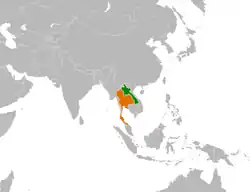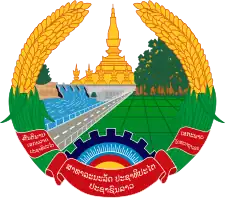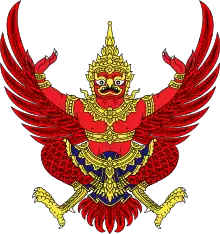 | |
Laos |
Thailand |
|---|---|
Laos and Thailand have had bilateral relations since the time of their precursor Lan Xang and Ayutthaya kingdoms in the 15th century. The two countries share a border and express linguistic and cultural similarities. The Lao kingdom of Lan Xang included all of northeastern Thailand as recently as the early 18th century.[1] Thailand's northeastern region, Isan, has particularly strong Lao roots. Linguistically, the inhabitants of Isan, a third of the Thai population, speak the Isan language, a Lao dialect.[1] Diplomacy has concentrated on the Mekong River, seeking to make it a "river of true peace and friendship", as made explicit in statements by both respective prime ministers in 1976.[2]
Diplomatic relations between the modern states were established in 1950, but cross-border cooperation began at the end of the Cold War.
History
1980-
In 1980, a minor incident involving live fire between patrol boats led Thailand to close its border with Laos. More significant border disputes and military clashes followed in 1984 and 1987 in Sainyabuli Province. These conflicts originated in rival claims to forest resources based on maps from the early days of the French protectorate.[2]
In 1988, Thai prime minister Chatichai Choonhavan opened the Indochina market, leading to a wave of goodwill gestures and business ventures between Laos and Thailand. Kaysone Phomvihan paid an official visit to Bangkok in 1989, his first since the brief 1979 rapprochement with Prime Minister General Kriangsak Chomanand. These gestures were followed by official visits from Princess Sirindhorn in March 1990 and Crown Prince Maha Vajiralongkorn in June 1992. As another gesture of goodwill in 1992 the Politburo removed from power military commander Army Chief of Staff General Sisavath Keobounphanh. While Keobounphanh had dealt closely and effectively with the Thai military command in restoring neighborly relations, his party colleagues accused him of personal corruption. This corruption of a senior party leader symbolized the fear among some Laotian leaders that the more prosperous Thais, "want to eat us".[2]
Two political issues between Laos and Thailand delayed rapprochement during the 1980s. One was an influx of Laotian migrants and refugees, whom Thailand saw as undesirable minority groups and refused to accept as immigrants. A related issue stemmed from the presence of Laotian and Hmong resistance groups using migrant camps as bases. The Hmong constituted approximately half of those living in the camps and tended to face lower chances of deportation, in part due to fear of reprisal and hope for national autonomy. Thailand officially announced its stance in July 1992. However, Laotian refugees who had not returned home or found third-country resettlement by 1995 would be classified as illegal immigrants and face deportation.[2]
Lao and Hmong resistance movements have persisted since 1975, but with the end of the Cold War, attempts to disrupt the LPDR and its Vietnamese military partners dwindled. The Ministry of Foreign Affairs continued to press the Thai military command to live up to its March 1991 agreement to disarm rebels and discourage Laotian sabotage operations. At the same time, Thailand made very clear its unwillingness to assimilate the Hmong refugees.[2]
The threat of a return of Vietnamese troops cautioned the Thai military, who preferred keeping Laos as a buffer state rather than a military line of contact with the Vietnamese. The Friendship Bridge could open the interior to more foreign trucking and commerce and make any foreign military presence in Laos more apparent.[2]
In December 2009, Thai soldiers evicted more than 4,000 Hmong asylum seekers from a holding center and deported them to Laos.[3] This action was criticized by Human Rights Watch and the US State Department.[4]
Despite their shared cuisine, language and border, scholars have noted that anti-communist ideology after the 1950s encouraged the idea of "Thainess", and a persistent belief in Thai superiority, leading "the population of central and southern Thailand [to] look to their northern borders with contempt".[1] Thamrongsak Petchlertanan, a historian at Rangsit University, claimed that the notion of Thai superiority is rooted in decades of nationalist education in Thai schools. The destruction of Vientiane by the Siamese army in 1778, for instance, is part of this narrative and has been proudly recounted to generations of Thai children.[1]
Anti-Thai sentiment in Laos
Relations between Laos and Thailand have been characterized by tension. Since ancient times, Laos opposed Siamese territorial expansion. Laotian surrogate rulers requested French colonial authorities of French Indochina to ask France to reclaim lost Lao territory on the Khorat Plateau and to reclaim the Emerald Buddha from Siam.[5] After achieving independence under a Communist rule, the present Laotian government has been pro-Vietnam. Thailand's influence is suspect in the views of the pro-socialist Laotian community. [6]
Mutual assistance
In 2012, the Thai government agreed to provide loan assistance to Laos for two infrastructure projects. The first loan of more than 718 million baht funded the construction of a 33 km (21 mi) road, that would be built from Phudu checkpoint in Thailand's Uttaradit Province to Parklai District in Sainyabuli Province, Laos. The second loan of more than 84 million Thai baht funded the second phase of development of Pakse Airport in Champasak Province.[7]
In October 2011, the Lao government presented 1.5 million baht to the Thai government as a gesture of solidarity with the victims of flooding in Thailand's central region.[8]
State visits
Thai Prime Minister Abhisit Vejjajiva visited Laos in December 2010 as part of the 60 year anniversary of relations between the two countries. He stated that it was "Thai government's policy to encourage the private sector and state enterprises to invest in Lao PDR while enhancing corporate social responsibility, which renders benefits to local communities and protects the environment at the same time".[9]
On 31 May 2012, Lao Prime Minister Thongsing Thammavong visited his Thai counterpart, Yingluck Shinawatra.[7]
Economic relations
Much of the Lao hydropower generated from dams on the Mekong and its tributaries has been exported to Thailand, which has benefited from the hydropower in developing its poorer areas, especially in Thailand's northeast.[10]: 221 Selling hydropower has brought in significant foreign exchange to Laos.[11]: 221
See also
References
- 1 2 3 4 Ward, Oliver (2016-12-03). ""They're so Lao": Explaining the Thai sense of superiority". ASEAN Today. Retrieved 21 January 2017.
- 1 2 3 4 5 6 Brown, MacAlister, and Joseph J. Zasloff. "Relations with Thailand". Laos: a country study (Andrea Matles Savada, ed). Library of Congress Federal Research Division (July 1994).
- ↑ "Thailand deports thousands of Hmong to Laos". BBC News. 2009-12-28. Retrieved 2016-10-22.
- ↑ Mydans, Seth (2009-12-28). "Thailand Evicts 4,000 Hmong to Laos". New York Times. Retrieved 21 January 2017.
- ↑ Søren Ivarsson (January 2008). Creating Laos: The Making of a Lao Space Between Indochina and Siam, 1860-1945. NIAS Press. pp. 166–. ISBN 978-87-7694-023-2.
- ↑ Keat Gin Ooi (2004). Southeast Asia: A Historical Encyclopedia, from Angkor Wat to East Timor. ABC-CLIO. pp. 772–. ISBN 978-1-57607-770-2.
- 1 2 "Laos, Thailand deepen cooperation" (PDF). Laoembassy.com. Archived from the original (PDF) on 2016-03-03. Retrieved 2016-10-22.
- ↑ "Lao govt assists Thai flood victims". Asiaone.com. 2011-10-17. Retrieved 2016-10-22.
- ↑ Vejjajiva, Abhisit. "TRANSLATION OF REMARKS BY H.E. MR. ABHISIT VEJJAJIVA, PRIME MINISTER OF THE KINGDOM OF THAILAND, AT THE OFFICIAL INAUGURATION OF NAM THEUN 2 MULTI-PURPOSE PROJECT". Royal Thai Embassy, Singapore. Retrieved 21 January 2017.
- ↑ Harrell, Stevan (2023). An Ecological History of Modern China. Seattle: University of Washington Press. ISBN 9780295751719.
- ↑ Harrell, Stevan (2023). An Ecological History of Modern China. Seattle: University of Washington Press. ISBN 9780295751719.

